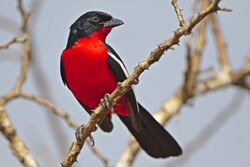Biology:Crimson-breasted shrike
| Crimson-breasted shrike | |
|---|---|

| |
| Adult bird at Pilanesberg | |
| File:Laniarius atrococcineus, roep te Buffelsdrift, kort, a.mp3 | |
| Scientific classification | |
| Domain: | Eukaryota |
| Kingdom: | Animalia |
| Phylum: | Chordata |
| Class: | Aves |
| Order: | Passeriformes |
| Family: | Malaconotidae |
| Genus: | Laniarius |
| Species: | L. atrococcineus
|
| Binomial name | |
| Laniarius atrococcineus (Burchell, 1822)
| |
The crimson-breasted shrike (Laniarius atrococcineus) or the crimson-breasted gonolek, ('gonolek' - supposedly imitative of its call),[2] or the crimson-breasted boubou, is a southern African bird. It has black upper parts with a white flash on the wing, and bright scarlet underparts. The International Union for Conservation of Nature has rated it as a "least-concern species".[1]
Taxonomy
The species was first collected by William John Burchell in 1811 near the confluence of the Vaal and Orange Rivers. He named it atrococcineus meaning 'black/red', finding the striking colour combination quite remarkable. The generic name Laniarius was coined by the French ornithologist Louis Pierre Vieillot and was meant to call attention to the butcher-like habits of the group. In South West Africa its colours reminded Germans of their homeland flag and it therefore became the Reichsvogel ("Empire bird"). The species is closely related to two other bushshrikes, the yellow-crowned gonolek (Laniarius barbarus) and the black-headed gonolek (Laniarius erythrogaster) of East Africa, but DNA research has shown that it does not form a superspecies with the yellow-crowned gonolek (L. barbarus), the black-headed gonolek (L. erythrogaster) and the papyrus gonolek (L. mufumbiri), as previously thought.[3]
Description
The sexes have the same colouration and are indistinguishable from each other. The upper parts, including the wings and tail, are black, the wings having a broad white bar. The underparts are vivid scarlet. A yellow-breasted form is occasionally seen, and was at first thought to be a separate species. Young birds have a mottled and barred buff-brown appearance with a pale bill.[4]
Behaviour
This shrike is extremely nimble and restless, its penetrating whistles often being the first sign of its presence, although it is not a shy species.[4]
Distribution and habitat
The crimson-breasted shrike is non-migratory and occurs in a broad swathe from southern Angola to the Free State province in South Africa and Northern Cape. Its preferred habitat is drier thornbush areas, in thickets and riparian scrub. It makes small seasonal migrations, preferring lower altitudes during cold periods.[4]
References
- ↑ Jump up to: 1.0 1.1 BirdLife International (2016). "Laniarius atrococcineus". IUCN Red List of Threatened Species 2016: e.T22707586A94130782. doi:10.2305/IUCN.UK.2016-3.RLTS.T22707586A94130782.en. https://www.iucnredlist.org/species/22707586/94130782. Retrieved 12 November 2021.
- ↑ "Shrike". Universalium. Academic. http://universalium.academic.ru/196551/shrike.
- ↑ Fry, H.. "Crimson-breasted Shrike (Laniarius atrococcineus)". Handbook of the Birds of the World Alive. Lynx Edicions, Barcelona. http://www.hbw.com/node/60517.
- ↑ Jump up to: 4.0 4.1 4.2 Harris, Tony (2010). Shrikes and Bush-shrikes: Including Wood-shrikes, Helmet-shrikes, Shrike Flycatchers, Philentomas, Batises and Wattle-eyes. Bloomsbury Publishing. pp. 245–246. ISBN 978-1-4081-3459-7. https://books.google.com/books?id=OqJCKm9adAkC&pg=P245.
- Tarboton Warwick (1971): Breeding biology of the Crimson-breasted Shrike at Olifantsfontein, Transvaal. Ostrich 42: 271-290
- Merkle Tobias (2006): Territoriality, breeding biology and vocalisations of the Crimson-breasted Shrike. Ostrich 77:136-141
External links
- Crimson-breasted shrike - Species text in The Atlas of Southern African Birds.
Wikidata ☰ Q1000262 entry
 |



